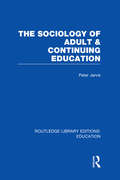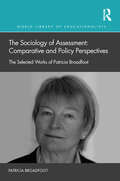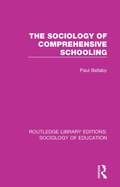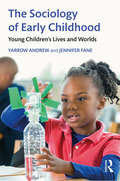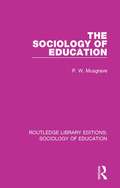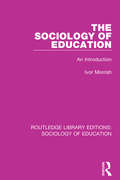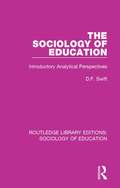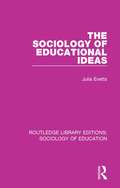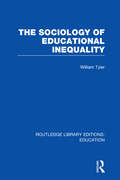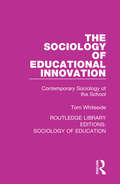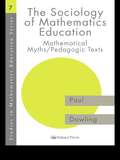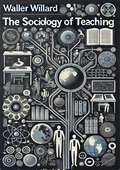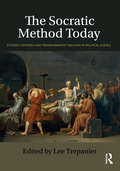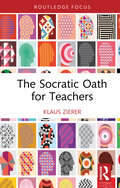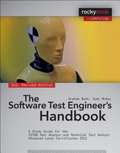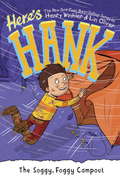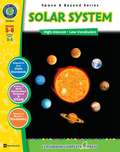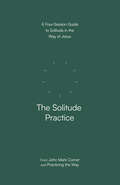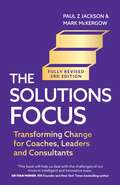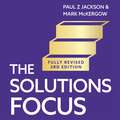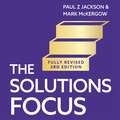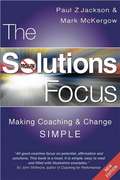- Table View
- List View
The Sociology of Adult & Continuing Education (Routledge Library Editions: Education)
by Peter JarvisThis book provides a comprehensive sociological overview of adult and continuing education. It draws on all branches of sociology rather than advocating one approach. It examines the theories of all the significant sociological writers in the field such as Knowles, Marx, Freire and Gramsci and sets them in the broader intellectual context. It also considers the content of the curriculum in adult education and the place of adult education in society at large. The author indicates the strengths and weaknesses of the different sociological perspectives and demonstrates how they can be used to analyse the function and purpose of adult and continuing education.
The Sociology of Assessment: The Selected Works of Patricia Broadfoot
by Patricia BroadfootIn the World Library of Educationalists series, international experts themselves compile career-long collections of what they judge to be their finest pieces – extracts from books, key articles, salient research findings, major theoretical and practical contributions – so the world can read them in a single manageable volume. Readers will be able to follow the themes and strands and see how their work contributes to the development of the field. In a collection of her most influential work spanning nearly four decades, Patricia Broadfoot applies her trademark sociological and comparative perspective to empirical studies at every level of the educational system. From her classic long-term study of the impact of changing national assessment policies on pupils and teachers in the classrooms of England and France to her sustained championship of the need for a better understanding of the impact of assessment on learning, Broadfoot has consistently championed the need for a more developed sociological understanding of assessment. Broadfoot’s accessible writing offers insights that are as novel as they are important for the education of future generations. This book allows readers to follow themes and strands across Patricia Broadfoot’s career and will be of interest to all followers of her work and any reader interested in the development of teaching, learning and assessment.
The Sociology of Comprehensive Schooling (Routledge Library Editions: Sociology of Education #5)
by Paul BellabyThis book, first published in 1977, attempts to unravel the complex debate behind the reorganisation of comprehensive secondary schools in Britain. It sets the British experience in perspective by comparing it with that of other Western European societies and into relief by contracts with the USA. The politics of reform are explored, and their social roots in changing class relations are discussed. This book will be of interest to students of sociology and education.
The Sociology of Early Childhood: Young Children’s Lives and Worlds
by Yarrow Andrew Jennifer FaneThe Sociology of Early Childhood brings a new perspective to the field of early childhood education, offering insights into how children's diverse backgrounds shape their life chances. This book will be invaluable for all early childhood educators and students, who want to explore the complexities of contemporary society. The book takes us through the lives of children from birth to eight years of age, highlighting key issues for babies, for toddlers and for older children, as they grow and learn. Exploring key aspects of inequality, such as gender, social class, race, disability, Indigeneity and sexuality, the sociological insights of this book help educators navigate their role as guides, mediators and advocates for young children. Whether it is understanding children's emotions, working with families, or understanding the challenges of climate change, this book will help, with practical and relevant knowledge. Traditional approaches to early childhood focus on individual children, often missing a critical awareness of social relationships. There has also been a narrow understanding of children's abilities at a given age or stage, which has ignored the significant impacts of power, privilege and disadvantage. Using sociological theory, the authors unpack how these big issues affect all aspects of children's lives, showing how children struggle to overcome the negative stereotypes which operate to diminish the life chances of many children. This book gives all those who care about or for young children the tools and understanding to become powerful advocates for a better childhood, and a better world.
The Sociology of Education (Routledge Library Editions: Sociology of Education #40)
by P W MusgraveFirst published in 1979, this third edition of The Sociology of Education at the time held the field as the standard textbook on the subject. It takes into account the changes that occurred in the field from the publication of the first edition in 1965 and the second edition in 1972. The book is divided into three parts: the first considers the way in which the child becomes a social being and the influences upon them of the family, the peer group and the mass media; the second deals with the sociology of schooling and looks at different types and stages of schools, as well as the attitudes and forms of interaction within them; and finally the third traces the relationship between education and social institutions, and looks at the balance between the preservation of social stability and the introduction of change.
The Sociology of Education: An Introduction (Routledge Library Editions: Sociology Of Education Ser. #39)
by Ivor MorrishFirst published in 1972, this book aims to provide an introduction to the teacher, or teacher in training, to society and its relationship to education. Although very much a product of its time rather than an instructive text for teachers in the 21st century, this work will be of interest to those studying the evolution of the study o
The Sociology of Education: Introductory Analytical Perspectives (Routledge Library Editions: Sociology of Education #54)
by Donald Francis SwiftFirst published in 1969, this book examines the educational process as a whole in relation to its society. The discussion is set within a specifically sociological frame of reference and looks at the school as an organisation as well as the social environment surrounding the school. It concludes by considering some of the basic issues concerning the functions of education for society. Written at a time when sociological studies of education were scarce, this ground-breaking work will be of interest to those studying education and its relationship with society.
The Sociology of Educational Ideas (Routledge Library Editions: Sociology of Education #22)
by Julia EvettsThis study, first published in 1973, examines the principles that lie behind educational dilemmas, and helps to clarify the difficulties of explanation, justification and practical action in the educational system. The author explores various key concepts in the education process, such as Intelligence, Equal Opportunity, Knowledge and Selection. She shows that different and often contrasting interpretations of these concepts imply certain assumptions about the nature of man, the genesis and knowledge, the education process and its relation to society. This title will be of interest to students of sociology and education.
The Sociology of Educational Inequality (Routledge Library Editions: Education)
by William TylerWhat is the most significant factor for explaining why some individuals are more successful than others – genetic inheritance, privileged background or luck? Although conventional approaches stress the prime importance of one of these, Tyler argues that such theories fail to deal adequately with the complexity of educational inequality and suggests that Boudon’s model of opportunity and mobility would provide us with a more productive explanation. By applying this model to post-war British education he shows how we might effectively think our approaches to the ‘cycle of deprivation’, comprehensive reform and educational spending.
The Sociology of Educational Innovation: Contemporary Sociology of the School (Routledge Library Editions: Sociology Of Education Ser. #58)
by Tom WhitesideInnovation is a striking and polemical feature of contemporary schooling. The 1960s saw an upsurge of interest in progressive educational theories and debate and the benefits and disadvantages of their practical application, which continued after. But what was the reality behind the words? How far had teachers actually supported or adopted innov
The Sociology of Mathematics Education: Mathematical Myths / Pedagogic Texts
by Paul DowlingUntil the 1960s, maths was studied as an academic subject in a desire to have more mathematicians. The current trend, however, has moved away from viewing maths as a purely intellectual endeavour and towards developing a more mathematically competent workforce and citizenry. This trend has seen a large increase in the number of maths schemes being produced by the major educational publishers, which attempt to make maths easier and more approachable by using language instead of symbols. So why do so many children still fail at maths? The author contends that to understand this, teachers need to analyze and evaluate the maths textbooks they are currently using. The author shows the reader how to systematically analyze and evaluate these textbooks. This interrogation of classroom resources, should have important implications for teaching strategies and for textbook design and use.
The Sociology of School Organization: Contemporary Sociology of the School (Routledge Library Editions: Sociology of Education #30)
by Ronald KingFirst published in 1983, this volume assembles recent theory on school organization, drawing on a wide range of research, mainly on schools in contemporary Britain but with some illuminating historical and overseas comparisons. It examines elements of organization both within and outside the school, and shows how they vary with the age, sex, ethnicity and social class of pupils, as well as school size and efficiency. It argues how, with understanding, organizational patterns may be changed to respond to new objectives and how they may become more effective and responsive to human needs in schools and classrooms.
The Sociology of Teaching
by Waller Willard"The Sociology of Teaching" by Waller Willard is a groundbreaking exploration of the complex social dynamics that shape the educational environment. Willard, a pioneering sociologist, provides a comprehensive analysis of the interactions between teachers, students, and the institutional structures within which they operate. This seminal work delves into the sociological aspects of teaching, offering profound insights into the roles, relationships, and cultural norms that influence the educational process.Willard's detailed examination covers various dimensions of the teaching profession, including the authority and social status of teachers, the impact of organizational culture on educational practices, and the intricate socialization processes that occur within schools. He explores the ways in which teachers' identities and behaviors are shaped by their social contexts, as well as the expectations and pressures imposed by society and educational institutions.One of the key contributions of "The Sociology of Teaching" is its analysis of the teacher-student relationship. Willard investigates how power dynamics, communication patterns, and social expectations influence interactions in the classroom. He highlights the reciprocal nature of this relationship, showing how both teachers and students affect and are affected by each other's behaviors and attitudes.Willard also addresses the broader societal implications of education, discussing how schools serve as agents of socialization, transmit cultural values, and contribute to social stratification. His work underscores the importance of understanding the social context of teaching to develop more effective educational policies and practices."The Sociology of Teaching" is an essential read for educators, sociologists, and policymakers interested in the intersection of education and society. Willard's rigorous research and insightful analysis provide a valuable framework for examining the social dimensions of teaching, making this book a timeless resource for those seeking to understand and improve the educational system.
The Socratic Method Today: Student-Centered and Transformative Teaching in Political Science
by Lee TrepanierThis exciting new textbook provides a sophisticated examination of the Socratic method for teaching political science students in higher education. It shows how the Socratic method is employed in the Platonic dialogs, compares its transformative approach to other student-centered teaching philosophies, and addresses the challenges of adopting the Socratic method in the contemporary classroom. The book is divided into three sections that integrate these practical aspects on the Socratic method with the theoretical considerations of Socratic philosophy while also addressing contemporary concerns about teaching and learning in higher education. Section One explores how the Socratic method is portrayed by Socrates in Plato’s dialogs. Section Two compares the Socratic method with modern and contemporary accounts of teaching and learning. Section Three examines some of the contemporary challenges of practicing the Socratic method in the university classroom today and how teachers can overcome them. Written in a clear and engaging style, this timely intervention is essential reading for upper undergraduate students enrolled in courses that specialize in pedagogical techniques, political theory, Socratic philosophy, and law.
The Socratic Oath for Teachers
by Klaus ZiererWhat makes a good teacher? In 1991, Hartmut von Hentig attempted to answer this when he first formulated a 'Socratic oath' for the profession, and it is a question which remains relevant today. In The Socratic Oath for Teachers, Klaus Zierer revisits and reframes the concept of a teacher’s oath while also addressing challenges currently facing our societal developments in recent didactic-methodological research and fresh perspectives on the goals of the teaching profession. Referencing Socrates throughout, this short think piece proposes a professional oath for teachers that at its core is fully committed to the successful education and well-being of students. Drawing upon key research and his own experiences within education, Zierer answers the following questions, establishing how a professional oath may support teachers: What is a professional oath, and what can it do? What characterises teacher professionalism? What can be understood by teacher attitudes? Why are they crucial for a successful professional oath? Why is Socrates suitable as a guarantor for a professional oath of teachers? Why is a renewal of the Socratic Oath necessary? For whom is an oath necessary, and what must it contain? In this fascinating work, Klaus Zierer explores the principles and goals of the teaching profession and formulates theoretically sound and empirically validated principles of successful teaching. This is an essential read for any teacher, senior leader, policy maker, educationalist, or researcher who wants to learn more about what makes a good teacher.
The Software Test Engineer's Handbook
by Judy Mckay Graham BathRevised and updated 1st Edition, 2011 There are a lot of books around covering functional testing techniques, but relatively few cover both functional and technical testing. This book will fill that gap. Authors Graham Bath and Judy McKay are core members of the ISTQB Working Party that created the new advanced level syllabus, which will be rolled out worldwide this year. This book brings both functional and technical aspects of testing into a coherent whole, which will benefit not only test analyst/engineers but also test managers. Based on the "Certified Tester" Advanced-Level syllabus issued by the ISTQB in 2007, the book covers everything you will need to know to successfully sit the examinations for Test Analyst and Technical Test Analyst. For those planning to take one or both of these exams, the book provides a solid base for preparation and clearly indicates which sections apply to which specific examination.
The Soggy, Foggy Campout (Here's Hank #8)
by Henry Winkler Lin Oliver Scott GarrettHere's Hank, the bestselling series written by Henry Winkler and Lin Oliver, is the perfect series for the transitional reader--easy-to-read font, simple and funny stories, and characters every kid would want to be friends with."We Love Nature Day" is fast approaching, and everyone in Hank's class gets to write and perform a poem. One problem: Hank has no idea where to start. Luckily his mom has a great idea--the family will go camping. Out in nature, Hank will be able to find plenty of inspiration. But when a rainstorm threatens to ruin their night, it's up to Hank to make sure the night doesn't turn into a soggy, foggy failure. Can he find the words for his nature poem--and the courage to help his family survive the night?From the Trade Paperback edition.
The Solar System
by Charlene HomerThis book provides ready-to-use information and activities for remedial students in grades five to eight. Written to grade using simplified language and vocabulary, science concepts are presented in a way that makes them more accessible to students and easier to understand. Comprised of reading passages, student activities and overhead transparencies, our resource can be used effectively for whole-class, small group and independent work.
The Solitude Practice: A Four-Session Guide to Solitude in the Way of Jesus
by John Mark Comer Practicing the WayDiscover how to step away from the noise of life and into a place of encounter with this guide from New York Times bestselling author John Mark Comer and the team at Practicing the Way.In our hyper-connected, constantly buzzing world, the practice of solitude is both countercultural and essential. The Solitude Practice provides a practical, accessible approach to incorporating this vital spiritual discipline into your life. Designed to be used with four engaging video sessions freely available online, this guide offers spiritual exercises, reflection questions, guided readings, and additional resources to help you and your community.This course guide will equip you to experience the power of solitude as you learn to:• Create a daily rhythm of quiet time with God• Encounter your true self and address avoided emotions• Combat spiritual enemies through Scripture-based reflection• Deepen your intimacy with God through listening and loving presenceDiscover how stepping away from distractions can lead to a transformed life, deeper self-awareness, and a renewed connection with God and others.Part of a series of nine core practices that together build a Rule of Life for following Jesus in the modern world, each guide can be read individually or together in any order:The Sabbath PracticeThe Prayer PracticeThe Fasting PracticeThe Solitude PracticeThe Generosity PracticeThe Scripture PracticeThe Community PracticeThe Service PracticeThe Witness Practice
The Solotype Catalog of 4,147 Display Typefaces
by Dan X. SoloThe author of many books on typography, Dan X. Solo was also the proprietor of his own typography shop in Oakland, California -- an establishment dedicated to unusual typography and special effects. This comprehensive catalog offers graphic designers a dazzling selection of over 4,000 typefaces and optical effects available from Solotype Typographers.Here, in Solo's words, is "a great cast of characters" -- the alphabet -- abetted by a cornucopia of typographical ideas and an endless resource of letters, words, phrases, slogans, logos, humorous comments, headlines, and graphic symbols. Individual sections of the book display a rich variety of typefaces in categories such as Condensed, Victorian, Art Nouveau, Art Deco, Rustic, Thick-and-tin, Calligraphic, Uncials, Latins, and Blackletter.Samples are imaginatively presented. "Stagecoach," for example, is printed in Fargo typeface, evoking dusty trails, rawhide, and ten-gallon hats, while "Sizzling summer savings" appears appropriately in the flamboyant Firebug typeface. All typefaces are indexed for quick and easy reference. As entertaining as it is practical and useful, this impressive treasury of versatile typefaces and optical effects will be indispensable to busy commercial artists as an inexhaustible source of typographic ideas and a "swipe file" of words, phrases, and letters for use in graphic art projects.
The Solutions Focus
by Mark Mckergow Paul Z. JacksonAuthors Mark McKergow and Paul Jackson coach readers in the new methods of problem-solving. This revolutionary, practical alternative to traditional problem-solving processes will help readers identify what is working within an organization and amplify it-placing the focus on what is possible, rather than what isn't.
The Solutions Focus, 3rd edition: Transforming change for coaches, leaders and consultants
by Paul Z. Jackson Mark McKergowSolutions Focus Practice is transforming coaching, consulting and leadership in organisations all over the world. A powerful yet simple approach to positive change, a solutions focus approach to people problems explores what works in a given situation and aims do more of it. The Solutions Focus is the definitive guide to this revolutionary yet practical alternative to conventional wisdom. It demonstrates how the unique SIMPLE method of working sidesteps the search for the causes of trouble and heads directly for the solution. Today national solutions focus associations around the world from Sweden to Australia, base their training on the methods explained here.Solutions focus is in widespread use by consultants, coaches, facilitators and managers. It can be applied at one-to-one, group or organisational levels. Applications include health and wellbeing, sales and negotiation, team building and leadership, performance management, organisational strategy and even peace-building and climate resilience. This long-awaited new edition of The Solutions Focus is fully revised and updated for today's executive, career and life coaches. Including the transformative OSKAR coaching framework, one of the most used throughout the coaching world.Revisions to this acclaimed book include updates throughout to position it in the contemporary landscape. Next generation developments are fully covered including new research on embodiment and experience, the role of hosting rather than directing, and the importance of detail. New case studies from around the world including Nestle, Kraft, Tate and Canon continue the book's legacy of learning from real cases by looking closely at what happens and how it works. Finally, new material exploring improvisation and co-constructed stories completes the update and will ensure this book remains the leader in its field for generations to come.
The Solutions Focus, 3rd edition: Transforming change for coaches, leaders and consultants
by Paul Z. Jackson Mark McKergowSolutions Focus Practice is transforming coaching, consulting and leadership in organisations all over the world. A powerful yet simple approach to positive change, a solutions focus approach to people problems explores what works in a given situation and aims do more of it. The Solutions Focus is the definitive guide to this revolutionary yet practical alternative to conventional wisdom. It demonstrates how the unique SIMPLE method of working sidesteps the search for the causes of trouble and heads directly for the solution. Today national solutions focus associations around the world from Sweden to Australia, base their training on the methods explained here.Solutions focus is in widespread use by consultants, coaches, facilitators and managers. It can be applied at one-to-one, group or organisational levels. Applications include health and wellbeing, sales and negotiation, team building and leadership, performance management, organisational strategy and even peace-building and climate resilience. This long-awaited new edition of The Solutions Focus is fully revised and updated for today's executive, career and life coaches. Including the transformative OSKAR coaching framework, one of the most used throughout the coaching world.Revisions to this acclaimed book include updates throughout to position it in the contemporary landscape. Next generation developments are fully covered including new research on embodiment and experience, the role of hosting rather than directing, and the importance of detail. New case studies from around the world including Nestle, Kraft, Tate and Canon continue the book's legacy of learning from real cases by looking closely at what happens and how it works. Finally, new material exploring improvisation and co-constructed stories completes the update and will ensure this book remains the leader in its field for generations to come.
The Solutions Focus, 3rd edition: Transforming change for coaches, leaders and consultants
by Paul Z. Jackson Mark McKergowSolutions Focus Practice is transforming coaching, consulting and leadership in organisations all over the world. A powerful yet simple approach to positive change, a solutions focus approach to people problems explores what works in a given situation and aims do more of it.The Solutions Focus is the definitive guide to this revolutionary yet practical alternative to conventional wisdom. It demonstrates how the unique SIMPLE method of working sidesteps the search for the causes of trouble and heads directly for the solution. Today national solutions focus associations around the world from Sweden to Australia, base their training on the methods explained here.Solutions focus is in widespread use by consultants, coaches, facilitators and managers. It can be applied at one-to-one, group or organisational levels. Applications include health and wellbeing, sales and negotiation, team building and leadership, performance management, organisational strategy and even peace-building and climate resilience.This long-awaited new edition of The Solutions Focus is fully revised and updated for today's executive, career and life coaches. Including the transformative OSKAR coaching framework, one of the most used throughout the coaching world.Revisions to this acclaimed book include updates throughout to position it in the contemporary landscape. Next generation developments are fully covered including new research on embodiment and experience, the role of hosting rather than directing, and the importance of detail.New case studies from around the world including Nestle, Kraft, Tate and Canon continue the book's legacy of learning from real cases by looking closely at what happens and how it works. Finally, new material exploring improvisation and co-constructed stories completes the update and will ensure this book remains the leader in its field for generations to come.
The Solutions Focus: Making Coaching and Change SIMPLE
by Mark MckergowThis is a new and updated edition of this acclaimed first business book on the powerful, simple yet subtle approach to positive change in people, teams and organisations. Used around the world by a wide range of people, professions and organisations, the first edition has now sold nearly 10,000 copies and been translated into 7 languages. Including new chapters reflecting the increasing importance of coaching and the solutions focus movement in the business environment, this wide-ranging book is filled with all the most important ideas, case examples and practical tips for managers, facilitators and consultants. Proven in many fields and with a distinguished intellectual heritage, "The Solutions Focus" provides a simple and direct route to progress in your organisation. It focuses on: solutions - not problems; in between: the action is in the interaction; make use of what's there; possibilities - past, present and future; and language. Every case is different. The trouble with traditional approaches to people problems is that they assume a straightforward relationship between cause and effect, between a problem and its solution. A solutions-focused approach sidesteps the search for the causes of a problem and heads straight for the solution, showing you how to envisage your preferred future and quickly takes steps forward. The authors present a set of practical techniques, including specific forms of questioning that lead to immediate action and results. They show how to identify what is working in your organisation and amplify it to make useful changes; to focus on what is possible rather than what is intractable and how to be solution focused, not solution forced.
